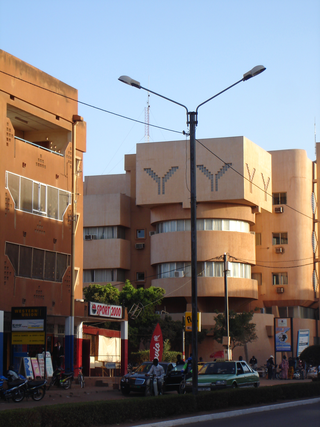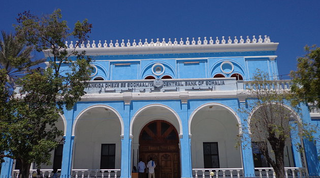Related Research Articles

The economy of Burkina Faso is based primarily on subsistence farming and livestock raising. Burkina Faso has an average income purchasing-power-parity per capita of $1,900 and nominal per capita of $790 in 2014. More than 80% of the population relies on subsistence agriculture, with only a small fraction directly involved in industry and services. Highly variable rainfall, poor soils, lack of adequate communications and other infrastructure, a low literacy rate, and a stagnant economy are all longstanding problems of this landlocked country. The export economy also remained subject to fluctuations in world prices.

The economy of Guatemala is a considered a developing economy, highly dependent on agriculture, particularly on traditional crops such as coffee, sugar, and bananas. Guatemala's GDP per capita is roughly one-third of Brazil's. The Guatemalan economy is the largest in Central America. It grew 3.3 percent on average from 2015 to 2018. However, Guatemala remains one of the poorest countries in Latin America and the Caribbean, having highly unequal incomes and chronically malnourished children. The country is beset by political insecurity, and lacks skilled workers and infrastructure. It depends on remittances for nearly one-tenth of the GDP.

The economy of Lesotho is based on agriculture, livestock, manufacturing, mining, and depends heavily on inflows of workers’ remittances and receipts from the Southern African Customs Union (SACU). Lesotho is geographically surrounded by South Africa and is economically integrated with it as well. The majority of households subsist on farming. The formal sector employment consist of mainly female workers in the apparel sector. While male migrant laborers work primarily as miners in South Africa for 3 to 9 months and employment in the Government of Lesotho (GOL). Half of the country's population work in informal crop cultivation or animal husbandry.

The economy of Malawi is $7.522 billion by gross domestic product as of 2019, and is predominantly agricultural, with about 80% of the population living in rural areas. The landlocked country in south central Africa ranks among the world's least developed countries. In 2017, agriculture accounted for about one-third of GDP and about 80% of export revenue. The economy depends on substantial inflows of economic assistance from the IMF, the World Bank, and individual donor nations. The government faces strong challenges: to spur exports, to improve educational and health facilities, to face up to environmental problems of deforestation and erosion, and to deal with the problem of HIV/AIDS in Africa. Malawi is a least developed country according to United Nations.

In ancient times, Maldives were renowned for cowries, coir rope, dried tuna fish, ambergris (maavaharu) and coco de mer (tavakkaashi). Local and foreign trading ships used to load these products in the Maldives and bring them abroad.

The economy of Moldova is an emerging upper-middle income economy, with a high Human Development Index. Moldova is a landlocked Eastern European country, bordered by Ukraine on the East and Romania to the West. It is a former Soviet republic and today a candidate member to the European Union.

Once a single-crop agricultural economy, Saint Lucia has shifted to a tourism and banking serviced-based economy. Tourism, the island's biggest industry and main source of jobs, income and foreign exchange, accounts for 65% of its GDP. Agriculture, which was once the biggest industry, now contributes to less than 3% of GDP, but still accounts for 20% of jobs. The banana industry is now on a decline due to strong competition from low-cost Latin American producers and reduced European trade preferences, but the government has helped revitalize the industry, with 13,734 tonnes exported in 2018. Agricultural crops grown for export are bananas, mangoes, and avocados. The island is considered to have the most diverse and well-developed manufacturing industry in the eastern Caribbean.

Somalia is classified by the United Nations as a least developed country, with the majority of its population being dependent on agriculture and livestock for their livelihood. The economy of Somalia is $4.918 billion by gross domestic product as of 2020. For 1994, the CIA estimated it at purchasing power parity to be approximately $3.3 billion. In 2001, it was estimated to be $4.1 billion. By 2009, the CIA estimated that it had grown to $5.731 billion, with a projected real growth rate of 2.6%. In 2014, the International Monetary Fund estimated economic activity to have expanded by 3.7% primarily. This expansion was driven by growth in the primary sector and the secondary sector. According to a 2007 British Chambers of Commerce report, the private sector has experienced growth, particularly in the service sector. Unlike the pre-civil war period, when most services and the industrial sector were government-run, there has been substantial, albeit unmeasured, private investment in commercial activities. The investment has been largely financed by the Somali diaspora, and includes trade and marketing, money transfer services, transportation, communications, fishery equipment, airlines, telecommunications, education, health, construction and hotels.
Poverty in Pakistan has been recorded by the World Bank at 39.3% using the lower middle-income poverty rate of US$3.2 per day for the fiscal year 2020–21. In September 2021, the government stated that 22% percent of its population lives below the national poverty line set at Rs. 3030 (US$10) per month.
The World Development Report (WDR) is an annual report published since 1978 by the International Bank for Reconstruction and Development (IBRD) or World Bank. Each WDR provides in-depth analysis of a specific aspect of economic development. Past reports have considered such topics as agriculture, youth, equity, public services delivery, the role of the state, transition economies, labour, infrastructure, health, the environment, risk management, and poverty. The reports are the Bank's best-known contribution to thinking about development.
Bangladesh is a developing nation. Despite rapid economic growth, poverty remains a major issue. However, poverty has declined sharply in recent history. Shortly after its independence, approximately 90% of the population lived under the poverty line. However, since economic reforms and trade liberalization of early 1990s, along with accelerated economic growth since early-2000s, Bangladesh have experienced a dramatic progress in reducing poverty. The remarkable progress in poverty alleviation has been recognized by international institutions. According to World Bank, more than 33 million Bangladeshi people have been lifted out of poverty since 2000; as measured by the percentage of people living on the equivalent of US$1.90 or less per day in 2011 purchasing price parity terms.
Nigeria had one of the world's highest economic growth rates, averaging 7.4% according to the Nigeria economic report that was released in July 2019 by the World Bank. Following the oil price collapse in 2014–2016, combined with negative production shocks, the gross domestic product (GDP) growth rate dropped to 2.7% in 2015. In 2016 during its first recession in 25 years, the economy contracted by 1.6%. Nationally, 43 percent of Nigerians live below the poverty line, while another 25 percent are vulnerable. For a country with massive wealth and a huge population to support commerce, a well-developed economy, and plenty of natural resources such as oil, the level of poverty remains unacceptable. However, poverty may have been overestimated due to the lack of information on the extremely huge informal sector of the economy, estimated at around 60% more, of the current GDP figures. As of 2018, the population growth rate is higher than the economic growth rate, leading to a slow rise in poverty. According to a 2018 report by the World Bank, almost half the population is living below the international poverty line, and unemployment peaked at 23.1%.
Poverty reduction in Guatemala remains as one of the key challenges to be dealt with before a more balanced and socially inclusive economic growth could be achieved.
The island country of Madagascar remains plagued by political and economic instability, poverty, and food insecurity. While the country engaged in an ambitious transformation program designed to improve social, economic, and governance indicators between 2002 and 2008, a 2009 political crisis has thrown these improvements off-course. This political strife, in combination with the global financial downturn, led to a 4 percent decline in economic growth in 2009.
It is estimated that 64 percent of the Mozambique population is food insecure. The prevalence is higher in the southern region .Mozambique net importer of food. Total annual cereal import requirements average 0.89 million tons. Mozambique must also import substantial quantities of meat and livestock products.

Climate change is a critical issue in Bangladesh as the country is one of the most vulnerable to the effects of climate change. In the 2020 edition of Germanwatch's Climate Risk Index, it ranked seventh in the list of countries most affected by climate calamities during the period 1999–2018. Bangladesh's vulnerability to the effects of climate change is due to a combination of geographical factors, such as its flat, low-lying, and delta-exposed topography, and socio-economic factors, including its high population density, levels of poverty, and dependence on agriculture. The impacts and potential threats include sea level rise, temperature rise, food crises, droughts, floods, and cyclones.

In 2021, official government statistics reported that the Philippines had a poverty rate of 18.1%,, significantly lower than the 49.2 percent recorded in 1985 through years of government poverty reduction efforts. From 2018 to 2021, an estimated 2.3 million Filipinos fell into poverty amid the economic recession caused by the COVID-19 pandemic.
In Afghanistan, poverty is widespread in rural and urban areas. However, it has been estimated that poverty in Afghanistan is mainly concentrated in rural areas. It has been estimated that four out of five poor people live in rural areas. In these rural areas, families without enough access to adequate nutrition see many infants and children become stunted, malnourished, and die each year. The regions in Afghanistan where almost half of the inhabitants are poor are the East, Northeast, and West-Central regions. According to the Afghan government's estimates, 42 percent of the Afghanistan's total population lives below the poverty line. Also, 20 percent of people living just above the poverty line are highly vulnerable to falling into poverty.
Cambodia remains on the list of developing countries, despite recent economic growth. Although Cambodia is undergoing significant urbanization. Cambodia has made progress in combating poverty, and many citizens have risen just above the poverty line
Energy poverty is defined as lacking access to the affordable sustainable energy service. Geographically, it is unevenly distributed in developing and developed countries. In 2019, there were an estimated 770 million people who have no access to electricity, with approximately 95% distributed in Asia and sub-Saharan Africa.
References
- ↑ "Moldova country profile". 2019-06-21. Retrieved 2019-08-11.
- 1 2 3 "NATIONAL HUMAN DEVELOPMENT REPORT 2015/2016 REPUBLIC OF MOLDOVA" (PDF). National Human Development Report 2016: Moldova. United Nations Development Programme. 2017. p. 42. Retrieved August 11, 2019.
- ↑ "Poverty & Equity Data Portal". povertydata.worldbank.org. Retrieved 2019-08-11.
- ↑ "Poverty headcount ratio at national poverty lines (% of population) | Data". data.worldbank.org. Retrieved 2019-08-11.
- ↑ "| Human Development Reports". hdr.undp.org. Retrieved 2019-08-11.
- ↑ "Making the most of emigration | UNDP in Moldova". UNDP. Retrieved 2019-08-11.
- ↑ Ito, Katsuya (2017). "Remittances and the Dutch Disease: Evidence from the Republic of Moldova". International Economic Journal. 31 (3): 451–471. doi:10.1080/10168737.2017.1326514. S2CID 157905409.
- ↑ International Organisation for Migration. 2012. Extended Migration Profile of The Republic of Moldova. 2012. Chisinau: IOM Mission to Moldova
- ↑ The Republic of Moldova National Human Development Report - 2006. pp. 58-59
- 1 2 3 United States Department of State • Bureau of Democracy, Human Rights and Labor. "MOLDOVA 2018 HUMAN RIGHTS REPORT" (PDF).
 This article incorporates text from this source, which is in the public domain .
This article incorporates text from this source, which is in the public domain .
